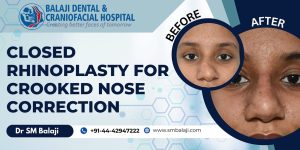[vc_section content_layout=”full” animation_delay=”” disable=”” id=”” class=”” bg_type=”image” bg_image=”” color_overlay=”” enable_parallax=”” enable_pattern=””][vc_row content_layout=”boxed” equal_height=”” animation_delay=”” disable=”” id=”” class=”” bg_type=”image” bg_image=”” color_overlay=”” enable_parallax=”” enable_pattern=””][vc_column layout=”normal” vertical_align=”top” animation_delay=””][vu_heading style=”2″ heading=”Patient with long standing facial asymmetry due to hemifacial microsomia” subheading=”” alignment=”left” custom_colors=”” class=””][vc_column_text]The patient is a young man from Thrissur, Kerala with hemifacial microsomia. His parents had slowly begun noticing a facial asymmetry as he grew up. The left side of the jaw was shorter than the right side as the corpus of the mandible was not growing normally and there was also a deformity of the left maxilla. He had also progressively developed difficulty chewing and with his speech.
They approached a local oral surgeon for diagnosis and treatment. It was explained to them that the patient had a high degree of facial asymmetry with a skewed occlusal cant. The surgeon had then informed them that facial asymmetry surgery in India was performed only in a few specialty centers. The patient and his parents were then referred by him to Balaji Dental and Craniofacial Hospital in Chennai.[/vc_column_text][vu_heading style=”2″ heading=”Treatment planning explained and consent obtained for distraction osteogenesis” subheading=”” alignment=”left” custom_colors=”” class=””][vc_column_text]Dr SM Balaji examined the patient and ordered detailed imaging studies including a 3D CT scan. Facial biometrics were then obtained, which revealed a 10 cm shortening of the ramus on the left side when compared to the right. It was decided to proceed with simultaneous maxillary and mandibular distraction for the patient. The treatment planning was explained in detail to the patient and his parents who consented to the surgery.[/vc_column_text][vu_heading style=”2″ heading=”Sagittal split osteotomy of the mandible” subheading=”” alignment=”left” custom_colors=”” class=””][vc_column_text]Under general anesthesia, a sagittal split osteotomy was performed on the left mandibular ramus. A Univector ramus distractor was then fixed with screws to the distracted segments of the mandible. Functioning of the distractor was checked before the incision was closed with sutures.
Attention was next turned to the maxillary distraction. A vestibular incision was performed followed by a Le Fort I maxillary osteotomy. Dysjunction of the maxilla was then performed on the left side followed by stabilization of the distracted segments.[/vc_column_text][vu_heading style=”2″ heading=”Establishment of facial symmetry through distraction osteogenesis” subheading=”” alignment=”left” custom_colors=”” class=””][vc_column_text]Distraction osteogenesis of the mandible would be performed after a latency period of seven days to allow for stabilization of the distracted site. This will be followed by a distraction of 1 mm everyday for a total of 10 mm of distraction in ten days. The distractors would be left in place for a period of three months for new bone to consolidate at the distracted site.
This would result in establishment of facial symmetry for the patient. The patient and his parents expressed their satisfaction at the results of the surgery before final discharge from the hospital.
[/vc_column_text][vu_heading style=”2″ heading=”Surgery Video” subheading=”” alignment=”left” custom_colors=”” class=””][vc_video link=”https://www.youtube.com/watch?v=Wd-OX3yGbEE”][/vc_column][/vc_row][/vc_section]





